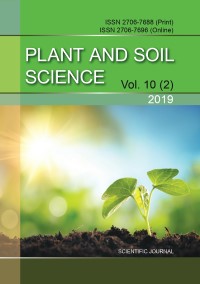Microbiological evaluation of the chernozem regraded by different fertilizer systems
DOI:
https://doi.org/10.31548/agr2019.02.054Keywords:
soil microbiological activity, black soil, microorganisms, fertilizer systems, organic matter, organic fertilizer systemAbstract
Microorganisms are very important in the formation of soils, ensuring their functioning as biosable bodies of nature and are an indicator of qualitative changes in the soil. As a result of anthropogenic impact, there is a decrease in the number and depletion of the species composition of the microbiota. Changes in the indicators of the microbiological activity of chernozem regraded under the influence of intensive, low-cost and organic fertilizer systems of maize were studied. The determination of the number of different groups of soil microorganisms was carried out by the method by D. G. Zvyagintsev by sowing soil suspension on solid nutrient substratum. It was found that the most favorable indicators of microbiocenoses were on the variant with an organic fertilizer system. Both the low agrochemical variant and the variant of the intensive system adversely influenced the processes of humification in the chernozem according to the content of pedotrophic and humate-decomposing organisms. With intensive technology, oligotrophic enhancement has been established, which causes competition for available nitrogen between microorganisms and plants. The number of amonifying organisms in the low-cost system was 2.03 times more relatively intensive and 2.3 – relative to the organic system, which indicates a tendency for organic substances to decompose.References
Nannipieri, P. , Ascher, J. , Ceccherini, M. T., Landi, L. , Pietramellara, G. and Renella, G. (2003), Microbial diversity and soil functions. European Journal of Soil Science, 54, 655-670. doi:10.1046/j.1351-0754.2003.0556.x.
Haiyan Chu, Xiangui Lin, Takeshi Fuji, Sho Morimoto, Kazuyuki Yagi, Junli Hu, Jiabao Zhang (2007). Soil microbial biomass, dehydrogenase activity, bacterial community structure in response to long-term fertilizer managementSoil Biology and Biochemistry,Volume 39, Issue 11, November 2007, Pages 2971-2976. https://doi.org/10.1016/j.soilbio.2007.05.031.
Patyka, M. V., Moskalevsʹka, YU. P. (2014). Biolohichna aktyvnistʹ ta mikrobna transformatsiya orhanichnoyi rechovyny chornozemu typovoho za riznykh system zemlerobstva [Biological activity and microbial transformation of organic matter of chernozem typical under different agricultural systems]. Zbalansovane pryrodokorystuvannya, 2, 68-72. Available at: http://nbuv.gov.ua/UJRN/Zp_2014_2_16.
Campbell, C. A., Lafond, G. P., Zentner, R. P., Biederbeck, V. O. (1991). Influence of fertilizer and straw baling on soil organic matter in a thin black chernozem in western Canada. Soil Biology and Biochemistry, 23, 5, 443-446. https://doi.org/10.1016/0038-0717(91)90007-7
Lopushnyak, V. I. (2013). Ekolohichnyy stan temno-siroho opidzoleno- ho gruntu za riznykh system udobrennya [Ecological state of dark gray podzolized soil for different fertilizer systems]. Ahroekolohichnyy zhurnal, 3, 47-52. Available at: http://nbuv.gov.ua/UJRN/agrog_2013_3_10.
Symochko, L. YU., Symochko, V. V., Bihariy, I. Y.(2010). Spryamovanistʹ mikrobiolohichnykh protsesiv u grunti ahrobioheotsenoziv pry zastosuvanni riznykh ahrozakhodiv [Direction of microbiological processes in the soil of agrobioogeocoenoses in the application of various agro-measures]. Scientific Bulletin of Uzhgorod University: Series: Biology. Uzhhorod: "Hoverla", 28, 47–51. Available at: https://dspace.uzhnu.edu.ua/jspui/handle/lib/7741
Malynovsʹka, I. M., Tkachenko, M. A., Sachok, V. H., Skumina, M. O. (2014). Vplyv ahrotekhnichnykh zakhodiv na mikrobni uhrupovannya siroho lisovoho gruntu. [Influence of agrotechnical measures on microbial groups of gray forest soil]. Problems of environmental biotechnology, 1. Available at: :http://nbuv.gov.ua/UJRN/peb_2014_1_8
Tonha, O., Balaev, A., Pikovska, O. (2017). Formuvannya mikrobnoho kompleksu chornozemu rehradovanoho za riznykh system udobrennya [Formation of microbial complex of chernozem regraded in different fertilizer systems]. Naukovyy visnyk NUBiP Ukrayiny. Seriya: Ahronomiya, 269, 148-153. Available at: http://journals.nubip.edu.ua/index.php/Agronomija/article/view/9675/8652
Ostapchuk, M. O., Polishchuk, I. S., Mazur, O. V., Palamarchuk, V. D. Mikrobiolohichni osnovy ahrotekhnolohiy (2016). Microbiological bases of agrotechnologies]. Agriculture and forestry, 3, 32-43.
Demydenko, O. V., Boyko, P. I., Litvinov, D. V., Kryvda, YU. I. (2017). Vykorystannya orhanichnykh resursiv dlya vidtvorennya rodyuchosti hruntiv v umovakh Cherkashchyny. [Use of organic resources for reproduction of soil fertility in the conditions of Cherkasy region]. Zemlerobstvo, 1, 54-61. Available at: http://nbuv.gov.ua/UJRN/Zemlerobstvo_2017_1_12 https://doi.org/10.31073/zem.92.54-61
Yeshchenko, V. O. (2011). Do metodyky vyznachennya biolohichnoyi aktyvnosti gruntu. [To a method of determining the biological activity of soil]. Zb. nauk. pr. Umansʹkoho NUS, 77, 21-26. Available at: :http://journal.udau.edu.ua/assets/files/others/-Zbirnik-UNUS-77.Ch.1.pdf#page=21
Zvyagintsev, D. (1976). Biologiya pochv i diagnostika [Soil Biology and Diagnostics]. Problems and Methods of Biological Diagnostics and Indication of Soils. Moscow: Science, 175-189.
Kolodyazhnyy, A. YU., Patyka, N. V. (2013). Formirovaniye mikrobnogo kompleksa pochvy v agrotsenoze ozimoy pshenitsy pod. vliyaniyem sistem zemledeliya. [The formation of the microbial complex of the soil in the agrocenosis of winter wheat under. the influence of farming systems]. Materials of the XIII Congress of the Society of Microbiologists of Ukraine. alta, 165.
Mishustin, E., Emtsev, V. (1987). Mikrobiologiya: uchebnik [Microbiology: a textbook]. Moscow: Agropromizdat, 368.
Downloads
Published
Issue
Section
License
Relationship between right holders and users shall be governed by the terms of the license Creative Commons Attribution – non-commercial – Distribution On Same Conditions 4.0 international (CC BY-NC-SA 4.0):https://creativecommons.org/licenses/by-nc-sa/4.0/deed.uk
Authors who publish with this journal agree to the following terms:
- Authors retain copyright and grant the journal right of first publication with the work simultaneously licensed under a Creative Commons Attribution License that allows others to share the work with an acknowledgement of the work's authorship and initial publication in this journal.
- Authors are able to enter into separate, additional contractual arrangements for the non-exclusive distribution of the journal's published version of the work (e.g., post it to an institutional repository or publish it in a book), with an acknowledgement of its initial publication in this journal.
- Authors are permitted and encouraged to post their work online (e.g., in institutional repositories or on their website) prior to and during the submission process, as it can lead to productive exchanges, as well as earlier and greater citation of published work (See The Effect of Open Access).

